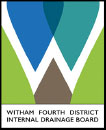Wrangle Sea Bank Project Summary
Project Name: Wrangle Sea Bank
Project Details: A £1.95M scheme to raise and reprofile 5.8km of primary sea defence along the Lincolnshire Wash Coastline that also created 10+ Hectares of improved habitat.
Project Lead: Peter Bateson W4IDB
Summary:
The storm tidal surge on 6 December 2013 breached coastal defences in two locations on The Wash shoreline and this galvanised the local rural community to push for action in an area previously identified by the Environment Agency (EA) Wash Banks Performance Review (2012) as being at high risk. A landowner led lobby group The Wash Frontagers, urged the EA for action. As a result, this partnership project, led by Witham Fourth District Internal Drainage Board (W4IDB), has successfully raised and re-profiled 5.8km of sea defences for just £1.95M (using £1.3M FCRM GiA and attracting £0.45M ERDF funding and £200K in-kind donation from landowners).
Completed in December 2018, this has improved protection for 438 properties and 3,400 hectares of prime farmland. In addition, the project enabled at least 10 hectares of habitat creation behind the banks including grassland and semi-wetland habitats. It was a sensitive project, as the area sits alongside The Wash, a Site of Special Scientific Interest (SSSI) and the spoil for the bank was donated in-kind by the local rural community giving up to 20 hectares of farmland, the fundamental component of the project. The completed bank will form part of the National Coastal Path in 2020.
Project detail:
Lincolnshire has a very strong Flood Risk and Water Management Partnership (The Partnership), led by Lincolnshire County Council (LCC) the Lead Local Flood Authority (LLFA), and includes active involvement by the EA, District Councils, Internal Drainage Boards (IDBs), which cover 40% of the County, and other environmental bodies. The Partnership is seen as a national exemplar and its strength and depth is borne from the collective appreciation of the threat posed to the lowland landscape by all risk management authorities (RMAs).
Informal discussions within The Partnership in the wake of the 2013 tidal surge suggested that the cost of a conventional procurement route through the EA would not be supported by the available benefits due to the rural location of the project. The EA subsequently approached Witham Fourth District IDB in early 2015 and we agreed to be the lead RMA on the project with support from the EA. This was primarily because we were able to deliver efficiencies using our relationship with the local rural community to establish agreements with landowners and we were able to procure local contractors. All the time spent leading and managing the project by W4IDB was given at no cost which represented significant time by both the Chief Executive and the Chief Engineer.
The project was included on the 6-year capital programme for the Anglian Northern Region RFCC and FCRM GiA funding would support construction of a bank to a height of 6.5 metres. In December 2015 the Local Enterprise Partnership (LEP) learned of the project and were keen to support it further. This led to a successful ERDF application to MHCLG in April 2016 to find additional funding under the growth agenda, to build a resilient profile bank to 7 metres, ensuring greater protection from the effects of climate change and giving local businesses the confidence to invest and grow. We believe this is the first time that ERDF funding has been used for a UK Flood Defence project. Due to the complexity of EU procurement rules and the ability of MHCLG as the administrator, to clawback funding after it is committed, this presented an unpalatable risk for W4IDB who were delivering a project with support from the EA. Again, discussion with The Partnership led to an offer by LCC to underwrite the risk of clawback, enabling this additional funding.
A full OJEU procurement exercise was done by LCC (as LLFA) on behalf of W4IDB and 10 compliant tenders were received. Using predetermined qualitative and value for money criteria, a preferred contractor was appointed in November 2017 and works began in Spring 2018.
In December 2017, fourteen separate landowner agreements were negotiated and signed by W4IDB that dictated the scope of the borrow area from which spoil could be taken for bank construction. Bushing work was done to ensure there were no nesting birds present as the works began in April 2018. Close liaison with Natural England was essential due to the proximity of the SSSI and a representative sat on the Project Board for the duration of the project. Construction was sympathetic to this sensitive area and only took place from April to September to avoid disturbing winter nesting birds and an ecological clerk of works was present throughout. Thankfully a dry summer saw completion of the main bank works in good time followed by the completion of fencing and other remedial works. The banks provide good amenity value as they’ll form part of the National Coastal Path in 2020.


